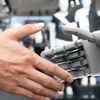The fashion industry is one of the largest industries globally, constituting two percent of the total global GDP (about $3 trillion).
A thriving sector in India, according to the latest study by the Indian Brand Equity Foundation (IBEF), the textile industry is estimated at around $108 billion and was expected to reach $223 billion by end of 2021.
The fashion industry employs over 105 million people, directly and indirectly, contributing almost 5 percent to the country’s GDP. In fact, the sector is one of the largest contributors to India’s export.
The industry has gone through its course of milestones and innovations — from the invention of the sewing machine to the rise of online shopping. The realms of fashion and technology are a perpetual dynamic of changes and seem to be inseparable.
Designers and brands are embracing the latest technologies like AI (Artificial Intelligence), ML (Machine Learning), Big Data, etc., to come up with cutting-edge substitutes of traditional processes and designs to keep up with the fast-changing fashion world.
In the last few years, the fashion world has seen various comebacks from the 80s and 90s, re-invention of accustomed design choices with a fresh outlook, and newer fashion trends and styles that continue to make headlines.
Here are some of the technology trends that will influence innovation in the fashion industry in the coming years:
Designers and style curators are making the most of artificial intelligence. AI can analyse past designs and predict future trends based on consumer behaviour and insights for a finer outcome.
An AI designed apparel can become a reliable strategy to automate the designing and fit process. This technology is also playing a major role in building a brand’s online presence with the help of chatbots to understand consumer expectations and demands and also enhance their online/ecommerce shopping experience.
Presently, personalisation at scale and customisation are some of the many pivots in the fashion business globally. AR (Augmented Reality) and 3D rendering software’s are making this a reality by assisting brands in mass personalisation, helping them build tailor-made apparel according to the customer’s needs.
Technology’s evolution in the fashion industry is changing the perspective of brands, specifically in terms of designing and product development of what could be the next big trend in the industry.
Trend forecasting, known to be a pretty labour-intensive task, is getting simplified with ML.
Machine learning is enabling brands to directly fetch data from users to plan upcoming styles and better inventory planning, thereby keeping themselves one step ahead in the fashion business.
The fashion and apparel manufacturing industry are exhaustively loaded with mundane tasks like sewing, multiple quality assurance cycles, determination of the fabric, etc.
Soon, these jobs will be taken over by AI-enabled machines and robots who will be tuned as per your requirement, which includes finding fault in fabrics, multiple quality assurance cycles, choosing the right colour combination, design, etc., making apparel manufacturing processes highly efficient and time-saving, thereby improving the industry’s sustainability.
In these times, when customers demand quick and secure delivery at their doorstep, supply chain management processes are getting integrated with ML and AI, along with other technological advancements, for better business management and customer experience.
These include:
· Increased scope of automated analysis of defects, damages, and quality inspection
· Supply chain lifecycle thrives on visibility and real-time tracking, ML coupled with IoT, and other technologies are filling the void to achieve faster and efficient deliveries
· Reducing response time, greater connectivity with logistics services, and real-time data analysis through ML is saving cost and enhancing productivity
· Accurate forecasting and reduced forecasting errors with ML is helping large companies to analyse a huge amount of data and get access to fairly accurate insights
Brands, designers, supply chain managers, and fashion and manufacturing companies are all leveraging the intelligence of technology to enhance their design skills, product development skills and leverage the best possibilities in this field.
Intelligent and automated fashion will be the new normal of this industry — leading to improvising and setting better standards of customer shopping experience in the Indian fashion industry in the years to come.
Edited by Suman Singh
(Disclaimer: The views and opinions expressed in this article are those of the author and do not necessarily reflect the views of YourStory.)

